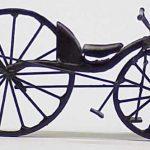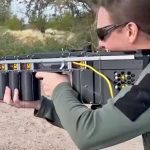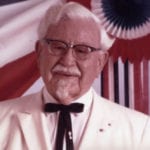 Mysteries
Mysteries  Mysteries
Mysteries  History
History 10 Surprising Stories About the Texas Rangers
 Humans
Humans 10 Philosophers Who Were Driven Mad by Their Own Theories
 Miscellaneous
Miscellaneous 10 Video-Game-Worthy Weapons and Armors from History
 Weird Stuff
Weird Stuff 10 Psychics Who Accurately Predicted Wartime Events
 The Arts
The Arts 10 Pieces of Art Inspired by a Broken Heart
 Health
Health 10 Science Fiction-Sounding New Medical Treatments
 History
History 10 Surprising Facts About the Father of Submarine Warfare
 Space
Space Ten Astonishing New Insights into Alien Worlds
 Weird Stuff
Weird Stuff 10 Bizarre Summer Solstice Rituals Still Practiced Today
 Mysteries
Mysteries Top 10 Haunting Facts About the Ghost Ship MV Alta
 History
History 10 Surprising Stories About the Texas Rangers
 Humans
Humans 10 Philosophers Who Were Driven Mad by Their Own Theories
Who's Behind Listverse?

Jamie Frater
Head Editor
Jamie founded Listverse due to an insatiable desire to share fascinating, obscure, and bizarre facts. He has been a guest speaker on numerous national radio and television stations and is a five time published author.
More About Us Miscellaneous
Miscellaneous 10 Video-Game-Worthy Weapons and Armors from History
 Weird Stuff
Weird Stuff 10 Psychics Who Accurately Predicted Wartime Events
 The Arts
The Arts 10 Pieces of Art Inspired by a Broken Heart
 Health
Health 10 Science Fiction-Sounding New Medical Treatments
 History
History 10 Surprising Facts About the Father of Submarine Warfare
 Space
Space Ten Astonishing New Insights into Alien Worlds
 Weird Stuff
Weird Stuff 10 Bizarre Summer Solstice Rituals Still Practiced Today
10 Children Who Are Changing the World, One Invention at a Time
Children are typically perceived as simply tiny human beings who are dependent on either their parents or an adult caregiver in order to survive. Given their lack of life experience and understanding of the world around them, they are often not regarded as individuals who have the capacity to think and ask questions for themselves.
However, while children and adolescents alike may see the world through a much more innocent and naive point of view, their open-mindedness and endless creativity also allow their minds to bloom in a way that an adult cannot.
Therefore, when the ten children on this list saw a need within the world or even their own families, they decided to take charge and put all their effort into finding a solution. From headphones that can play music while treating ear infections to shoes that can track and locate wandering dementia patients to a cane that can guide its user around their environment, these 10 children and teens are certainly changing the world, one clever invention at a time.
Related: 10 Accidental Inventions That Changed The World
10 Alexis Lewis
In 2011, the country of Somalia was stricken by a tragic famine due to a severe drought. Unfortunately, the drought, in combination with the country’s political unrest, only worsened the crisis.
In light of the famine, parents began seeking shelter for their families at refugee camps and emergency food centers. However, given that the children were malnourished and only growing weaker during the journey to safety, many mothers began abandoning their dying children along the roadside.
When 12-year-old Alexis (formerly Chase) Lewis of Chapel Hill, North Carolina, heard of the heart-wrenching decisions Somali refugees were facing, she knew she had to do something to help. So she did. She invented the Rescue Travois.
Lewis designed the Rescue Travois to be a triangular-load-carrying device on wheels made with a bamboo frame and netting, and it was also collapsible. The unique design allows the travois to be shipped in its flattened state and even air-dropped to those in need.
Lewis’s Rescue Travois will ensure the safety of children and families in the future should they need to reach a refugee center. The travois also benefits those in rural Africa by assisting with daily tasks and allowing those in need of medical attention to reach and receive treatment in a timely manner.
Lewis also went on to develop an Emergency Mask Pod—a football-shaped canister that contains a smoke mask, goggles, and an LED light strip—which can be thrown through a window and provide assistance to those trapped during a fire.[1]
9 Leanne Fan
While ear infections are a common occurrence in infants and toddlers, they can lead to permanent hearing loss if left untreated. Unfortunately, children in low-and-middle-income countries are even more prone to hearing loss due to their lack of access to medical care and preventative treatment.
However, 14-year-old Leanne Fan of San Francisco, California, firmly believed that “healthcare should be available to everyone because it’s our health and it is a matter of life and death.”
So Fan began studying Niels Finsen, who was awarded the Nobel Prize in 1903 for using light therapy to treat diseases such as lupus vulgaris, the most common form of tuberculosis. She knew that she could use this approach to help underprivileged children and adults who suffer from ear infections and are unable to receive medical treatment.
This led Fan to invent a set of low-cost headphones, which she rightfully named Finsen Headphones., They use blue light therapy to not only detect but also treat ear infections in children, potentially reducing hearing loss due to ear infections by 60 percent.
Fan understood, however, that a child suffering from an ear infection may not be cooperative in wearing the headphones, so she took her invention one step further. She designed them so that children could listen to their favorite music through the headphones while receiving treatment.
In October 2022, Fan was awarded the title of America’s Top Young Scientist after submitting her headphones to the 3M Young Scientist Challenge. Along with the prestigious title, she received a $25,000 cash prize and a special destination trip.[2]
8 Kristopher Bayog
While dementia is not considered a “disease,” it is a debilitating condition that affects one’s ability to recall past events, think critically, and even make everyday decisions. Additionally, more than 55 million people worldwide have dementia, for which there is no cure.
Eight-year-old Kristopher Bayog of Watsonville, California, understood the difficulties of dementia, given that his grandmother suffered from the condition. However, when his grandmother got separated from the family during his cousin’s graduation, his concerns for his grandmother’s safety grew. This led to an invention that would help not only those who suffer from dementia but also their family members: the “D Shoes.”
Bayog’s design for the “D Shoes” was modeled after the car key fob he had watched his father use to locate the family’s car in a parking lot. The shoes contain three AAA batteries that power a doorbell-like alert mechanism which is housed in the sole of the shoes. There are also speakers placed in the shoes’ heels.
When someone with dementia wears the shoes and becomes lost or separated, a keychain transmitter button can be pressed, which sounds an alarm, locating the wearer up to 1,000 feet (0.3 km) away.
“D Shoes,” however, are not Bayog’s only invention. He has also begun working on a device that will convert salt water into safe drinking water and is also exploring how the natural abilities of water-storing tropical plants can be used as a basis to create reusable water bottles.[3]
7 Bishop Curry
Since 1990, over 1,051 children have died after being left in hot cars due to knowingly or unknowingly being left behind in a vehicle or the child gaining access to the vehicle on their own. Yet regardless of the circumstance, the tragic outcome remains the same—the loss of an innocent child’s life.
So when 11-year-old Bishop Curry of McKinney, Texas, saw a local news report about a six-month-old from his neighborhood who died after being left inside a hot car, he was determined to find a way to prevent this type of tragedy from happening again.
Curry’s invention, which he named “Oasis,” is a device that can be attached to either a headrest or a car seat inside a vehicle. Through the use of GPS technology, Oasis can detect if the vehicle has come to a stop, a child has been left in a car seat, and the interior temperature of the vehicle begins to rise.
From there, once the vehicle reaches a certain temperature, a fan will automatically turn on and begin blowing cold air on the child. Additionally, once the fan has been activated, a built-in antenna will use Oasis’s Wi-Fi connection to contact the child’s parents. However, if the parents are unresponsive, an alert will be sent to local authorities notifying them of a child in danger and supplying law enforcement with the child’s GPS location.[4]
6 Kylie Simonds
Rhabdomyosarcoma is a type of cancer found within the soft tissue, connective tissue, or bone, and sadly is the most common type of soft tissue cancer in children.
Thankfully, eight-year-old Kylie Simonds of Naugatuck, Connecticut, was able to beat her rhabdomyosarcoma diagnosis. She is now in remission after enduring 46 weeks of chemotherapy treatment along with radiation treatment and other surgeries.
While Simonds no longer has to endure chemotherapy treatments, she understands the immobility issues that those receiving chemotherapy or transfusions face. She herself was often too weak to walk and would trip over the IV pole wires when she did try to walk.
Therefore, at age 11, when Simonds was given a classroom assignment to create something that would solve an everyday problem, she had just the solution—an IV pediatric backpack for kids.
With the assistance of her parents and advice from her doctors and nurses, Simonds was able to transform a Hello Kitty backpack into a prototype. It featured a built-in IV controller and a protection cage that would allow children to be mobile during their treatment, all without the fear of being tied to an IV pole or puncturing their medicine bag.
Needless to say, Simonds’s teacher was impressed, and Simonds was chosen to attend the Connecticut Invention Convention. She received four awards during the convention. One of them was the “Patent Award,” which is not only the highest award given but also gave Simonds the opportunity to have her invention submitted to the U.S. Patent and Trademark Office while a sponsor covered all the necessary costs.[5]
5 Ann Makosinski
In the Philippines, approximately 30% of its inhabitants do not have access to reliable electricity.
Therefore, when 15-year-old Ann Makosinski of Victoria, British Columbia, Canada, learned that one of her friends living in the Philippines was failing in school due to a lack of electricity and limited daytime study hours, her idea for the “Hollow Flashlight” was born.
Rather than using batteries, her flashlight uses four Peltier tiles. Peltier tiles are two ceramic tiles placed on top of one another with a conductor in the middle. In addition to the Peltier tiles, Makosinski added a transformer and a circuit that allows it to be powered solely by the user’s body heat, specifically their hand.
The “Hollow Flashlight” won first place in the 2013 Google Science Fair, and Makosinski was awarded a $25,000 prize.
Makosinski also went on to develop the eDrink coffee mug, which uses the excess heat of a hot beverage and turns it into electricity that can be used to charge a smartphone.[6]
4 Justin Rivard
School shootings have become a tragic reality in the United States, with over 288 school shootings having occurred since January 1, 2009, a statistic that is 57 times higher than other major world nations.
Fifteen-year-old Justin Rivard of Somerset, Wisconsin, noticed the flaws in his high school’s emergency response plan. So he decided to use his love of welding to create a solution for schools facing active shooter threats—the JustinKase.
It took time and dedication to refine his final product. Using a combination of steel plates, rods, and a locking knob, Rivard was able to weld and create a product that can be placed under the door of a classroom (Link 36) and latched to the doorjamb. This can prevent the door from being opened under any circumstance, even when applying immense pressure.[7]
3 David Cohen
Malaria is a disease that is spread to humans after being bitten by a parasite-infected mosquito.
Twelve-year-old David Cohen of Dallas, Texas, realized the huge mosquito problem in his state even before watching his sister endure weeks’ worth of antibiotics after getting a staph infection from scratching a mosquito bite. So Cohen began diligently working on a solution to reduce the number of malaria and West Nile Virus cases that were emerging due to mosquitos.
Cohen created a robot that could kill immature mosquitos while still in the larval stage, thereby preventing mosquito-borne illnesses. However, Cohen didn’t stop there.
A year later, at the age of 13, Cohen saw local news reports about the destruction left behind by a tornado in Granbury, Texas, and began to wonder how victims could be rescued and located among all the rubble left behind.
Typically, fire departments and emergency responders are sent during search and rescue missions. However, dogs are also used during these missions, given their incredible sense of smell, agility, and ability to focus on the task at hand in lieu of any outside distractions. So Cohen thought there must be a better and safer way to complete these missions.
Cohen’s curiosity, combined with a science lesson about earthworms, led him to develop a robotic earthworm that could travel underground and rescue those who were trapped. It would also send vital supplies to them.[8]
2 Riya Karumanchi
Canes can be a beneficial tool for those who have endured an injury or suffer from weakness in their lower extremities. More so, canes can provide a sense of stability and safety when walking for those who are elderly as well as those who are blind or visually impaired.
However, when 14-year-old Riya Karumanchi of Burlington, Ontario, Canada, met her friend’s visually impaired grandmother for the first time, she couldn’t help but notice the struggles the elderly woman faced trying to use her cane to navigate through the home.
This led Karumanchi to develop the Smart Cane, a cane with built-in GPS navigation that can guide its user with turn-by-turn directions. For example, one buzz indicates that a left turn is needed, while two buzzes will direct the user to make a right turn.
The cane also has the ability to alert and notify first responders as well as the user’s family members should they fall for any reason.[9]
1 Jack Andraka
While doctors are not certain about the specific causes of pancreatic cancer, the cancer occurs due to mutations in the DNA of pancreatic cells.
As the cancer progresses throughout the body, symptoms such as weight loss, jaundice, abdominal pain, and bowel obstruction occur. Unfortunately, because these symptoms do not appear until after the cancer has spread to other organs, it is typically not detected in the early stages. This makes successful treatment much more difficult.
Thirteen-year-old Jack Andraka of Crownsville, Maryland, knew first-hand just how aggressive pancreatic cancer could be after losing a family friend to the disease. However, Andraka used this tragedy as a motivator to change pancreatic cancer testing.
Andraka read a science paper regarding applications for carbon nanotubes—narrow tubes composed of carbon atoms that can be used for nanotechnology and as thermal conductors. Then, after listening to his biology teacher’s lecture about antibodies, Andraka used the combination of ideas to develop a test that could detect pancreatic cancer much sooner.
Andraka’s test would use a nanotube network laced with specific mesothelin antibodies. These mesothelin proteins are believed to be a cancer marker.
While it took nearly a year of hard work, Andraka was able to create a test that uses filter paper and a dipstick-like sensor to detect not only pancreatic cancer but also other cancers much sooner.[10]








